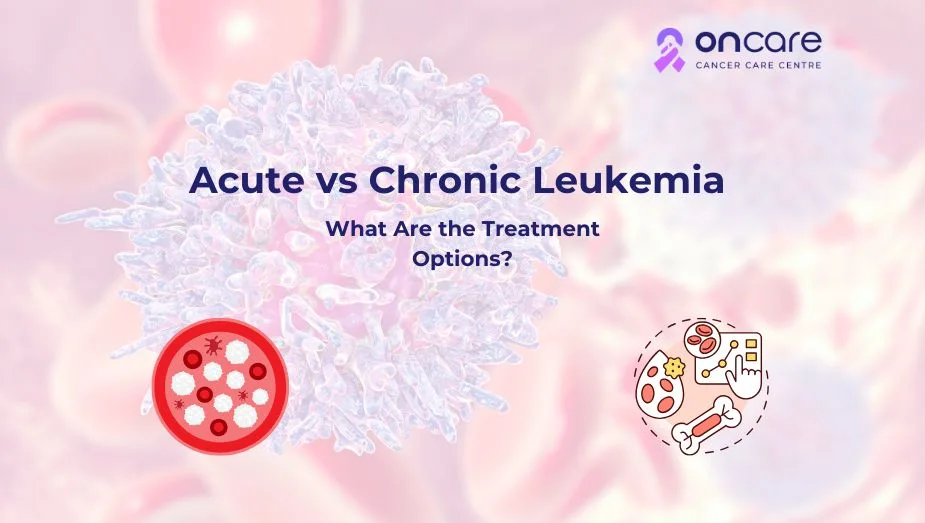Table of Contents
Acute vs Chronic Leukemia: What Are the Treatment Options?

Leukemia is a type of cancer that affects the blood and bone marrow and appears in various forms. There are two main types of acute and chronic leukemia. Each type of leukemia progresses differently and requires unique treatment options.
In this article, we’ll explore the differences between chronic vs. acute leukemia and major treatment options for both these diseases!
What are the different types of Leukemia?
Leukemia is classified into mainly four types based on how rapidly the disease spreads and the types of blood cells it starts to affect. The Acute leukemias are mostly observed as aggressive, developing quickly, while chronic leukemias often progresses slowly.
Additionally, leukemias are classified into ‘Lymohocytic’ or ‘myeloid’ mainly depending on whether they affect lymphoid cells or myeloid cells, which are different types of cells in the blood.
There are four main types of leukemia, including:
- Acute Lymphoblastic Leukemia (ALL): These types of leukemias are fast-growing and common in children.
- Chronic Lymphocytic Leukemia (CLL): These types of leukemia are slow growing and commonly found in older adults.
- Acute Myeloid Leukemia (AML): This is also fast-growing leukemia and commonly found in both children and adults.
- Chronic Myeloid Leukemia (CML): This type of leukemia develops slowly and its more commonly found in adults.
What is Acute Lymphoblastic Leukemia?
Acute Lymphoblastic Leukemia (ALL), is a rare type of leukemia that affects lymphocytes which is a type of white blood cells. This type of leukemia develops in the bone marrow, however it can spread and metastasize throughout the body.
This type of blood cancer is most common in children, although it can develop in anyone. The age group in which acute lymphoblastic leukemia is commonly developed in children is 2 to 5. This type of leukemia is a serious health condition, but undergoing effective treatment can cure many cases.
Types of acute lymphoblastic leukemia
The two main types of acute lymphoblastic leukemia are:
- B-cell acute lymphoblastic leukemia
- T-cell acute lymphoblastic leukemia
What is Chronic Lymphocytic Leukemia?What is Chronic Lymphocytic Leukemia?
Chronic Lymphocytic Leukemia (CLL) is a type of blood cancer. It is the most common form of leukemia observed in adults. This type of blood cancer develops when the healthy white blood cells (lymphocytes) in the bone marrow start to mutate or turn into cancerous cells that multiply, spread, and crowd out healthy blood cells and platelets.
This type of blood cancer mostly affects people in the age group between 65 and older, and it can develop in people who are 30 as well. People can have this disorder without showing any clear signs or symptoms.
Types of chronic lymphocytic leukemia
There are two main types of chronic lymphocytic leukemia are:
- B-cell chronic lymphocytic leukemia
- T-cell prolymphocytic leukemia
Treatment options for Acute Lymphoblastic Leukemia (ALL)
Many healthcare providers often treat acute lymphoblastic leukemia with treatments including chemotherapy, targeted therapy, immunotherapy, and bone marrow transplant or a mix of treatments.
The treatment options mainly depend on certain specific markers found on the cancer cells.
However, kids and adults might get different types of medicine and treatment practices.
Chemotherapy
Chemotherapy is a major treatment used for acute lymphoblastic leukemia. This treatment often gives four phases, with a goal of achieving remission. Remission means that there are no symptoms and no signs of cancer in the body.
The treatment can last around several months to several years. Sometimes it often involves using high doses of cancer-fighting drugs.
Targeted therapy
Targeted therapy is performed on patients with gene changes that make the cells change. Most cancer specialists use a type of targeted treatment also called Tyrosine Kinase Inhibitor (TKI) therapy.
This therapy is often given to patients who have a specific mutation commonly known as the Philadelphia Chromosome (BCR/ABL).
Immunotherapy
Immunotherapy is also used in ALL Patients to stimulate their immune system to attack or destroy cancer cells. For example, Blood cancer cases such as monoclonal antibodies or CAR-T cell therapy.
Radiation therapy
Many cancer specialists use radiation therapy to treat acute lymphoblastic leukemia that often returns or refuses chemotherapy.
Bone marrow transplant
If any other cancer treatments don’t stop or provide relief from any symptoms of this cancer, then the doctor may recommend to undergo bone marrow transplant.
Treatment options for Chronic Lymphocytic Leukemia
The common CLL treatments include treatments such as targeted therapy and chemotherapy. Many cancer specialists may also use radiation therapy to cure and heal CLL symptoms. However, each treatment option might cause different side effects and challenges.
The healthcare team shares some specific treatment options, side effects, and potential health complications.
Targeted therapy
This is another effective cancer treatment that focuses on targeting cancer cells. Treatments used for Chronic Lymphocytic Leukemia (CLL) helps to control cancerous white blood cells growing. However, targeted therapy helps to destroy the cells without hurting healthy cells.
Some of the treatments including:
- Bruton’s Tyrosine Kinase(BTK) Inhibitor Therapy
- BCL2 Inhibitor Therapy
- Monoclonal antibody therapy
Chemotherapy
Oncologists might use chemotherapy as a primary cancer treatment for chronic lymphocytic leukemia.
Here are some of the common chemotherapy drugs used for the CLL, including:
- Fludarabine
- Chlorambucil
- Cyclophosphamide
- Bendamustine
Immunotherapy
Cancer specialists use immunotherapy to strengthen or restore the immune system. With the help of this treatment, it destroys more cancerous cells. It helps to slow down cancerous cell growth. The medical team might use immunotherapy drugs such as lenalidomide to treat chronic lymphocytic leukemia that hasn’t responded to chemotherapy. It is also used in recurrent CLL or CLL that’s getting worse in people.
Consult Today
While, a recent leukemia diagnosis can be emotionally distressing and triggering to handle. However, understanding the treatment options and how they differ between being chronic and acute forms helps to empower us to make more informed decisions. New treatments options keep evolving, offering many patients hope and better treatment outcomes!
At Oncare, we provide high-quality cancer treatments, including surgeries, at affordable rates, along with consultations from experienced cancer specialists!
If you or any loved ones of yours are diagnosed with cancer, then visit Oncare Cancer Center and book an appointment with our cancer specialists today. Get an estimated cost of your cancer treatments today!
Frequently Asked Questions
The common symptoms including:
- Fatigue
- Fever
- Swollen lymph nodes
- Night sweats
- Sudden weight loss
- Pain
- Experiencing a sense of fullness under the ribs
There are two types of chronic lymphocytic leukemia, including:
- B-cell chronic lymphocytic leukemia
- T-cell prolymphocytic leukemia
There are mainly two types of acute lymphoblastic leukemia, including:
- B-cell Acute lymphoblastic leukemia: This is the most common subtype of leukemia, affects the B-cells that make antibodies and fight infection in the bodies. This accounts about 85% of cases of childhood leukemias and 75% to 80% of all adult cases.
T-cell Acute lymphoblastic leukemia: This affects T cells, which destroy germs and support other immune cells. It makes up approximately 25% of adult cases and accounts for 12% to 15% of childhood cases.
The symptom of acute leukemia include:
- Bleeding (Includes frequent nosebleeds or menstrual pains)
- Bruising
- Fatigue
- Constant infections
- Joint pain
- Loss of appetite
- Night sweats
- Shortness of breath
- Swollen lymph nodes
- Sudden weight loss

